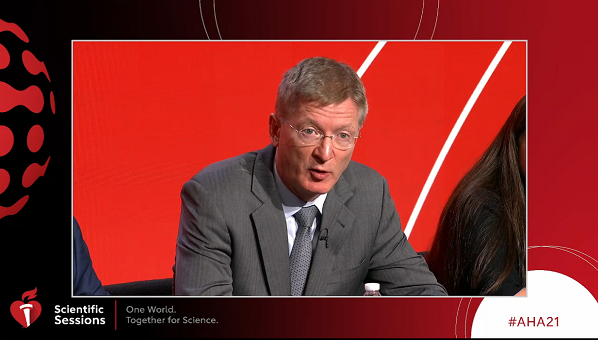External Support for Vein Grafts in CABG Doesn’t Help Patency: VEST
The results were likely affected by the higher-than-expected rate of vessel occlusion preventing IVUS at 1 year, says John Puskas.

Supporting saphenous vein grafts used in CABG with a novel external stent-like device did not decrease the degree of intimal hyperplasia seen at 1 year compared with unsupported grafts, but researchers say further research is needed to refine the technique and mitigate early graft occlusion that may improve long-term patency.
With limited durability, about half of vein grafts fail within 10 years of CABG, explained John D. Puskas, MD (Mount Sinai Beth Israel, Mount Sinai Morningside, New York, NY), who presented the findings of the VEST trial yesterday during a late-breaking trial session at the virtual American Heart Association 2021 Scientific Sessions. “An external support of saphenous vein grafts has the theoretical potential to prevent saphenous vein graft dilation—the initiator of that intimal hyperplasia—and thereby slow the rate of intimal hyperplasia and increase long-term vein graft patency by reducing vein graft wall tension, reducing lumen irregularities, preventing dilation, and improving hemodynamic and shear force stresses within the graft,” he explained.
The novel venous external support (VEST) device made with a braided weave of cobalt-chromium is designed to be placed over vein grafts to provide permanent reinforcement in the coronary position.
For the study, Puskas and colleagues enrolled 224 patients (mean age 65.8 years; 20.5% women) with multivessel disease slated for CABG with at least two saphenous vein grafts—one on the right and one to a non-LAD lesion on the left—at 17 US and Canadian centers between January 2018 and February 2019. The trial was designed so that each patient had one vein graft randomized to support with the VEST device and one serving as a control.
Overall, 203 patients returned for evaluation of intimal hyperplasia evaluation on angiography at 1 year, but because of occluded or diseased vein grafts or technical issues only 113 had completed IVUS of both grafts. Puskas said the researchers initially estimated that only 13% of patients would have occluded vessels preventing IVUS—a proportion substantially lower than the 42% they saw.
At 12 months, they observed no difference in the primary endpoint of intimal hyperplasia area between supported and unsupported grafts (mean 5.11 vs 5.79 mm2; P = 0.072). A prespecified sensitivity analysis, however, of the 113 patients with complete IVUS data of both grafts, hinted at a signal of benefit (mean 4.58 vs 5.12 mm2; P = 0.043), but the higher than expected rate of occluded/diseased vessels clouds interpretation of this observation.
Lumen diameter uniformity as measured by the 3-point Fitzgibbon classification at 12 months, a secondary endpoint, was similar with no intimal irregularity seen in 59.5% of supported and 53.5% of unsupported grafts. Graft failure rates, too, were comparable, with 30.2% of supported and 26.2% of unsupported grafts having at least 50% stenosis at 12 months.
Use of the VEST device was safe with an all-cause mortality rate of 2.2% as well as a MACCE rate of 7.1% at 1 year.
Why the Missed Endpoint?
The higher-than-expected rate of vessel occlusion and disease “certainly had an impact on our primary endpoint analysis, because it necessitated that we had to impute more data than we had anticipated,” Puskas said, adding, “Early failure of vein grafts is typically clinically silent and more frequent than I think we would like to acknowledge.”
Also, since arterial grafts are preferred to vein grafts in contemporary CABG practice, they will be used in the “best coronary targets,” Puskas observed. “So, if we are intentionally assigning vein grafts to the worst vessels on the coronary system, patency is likely to be reduced.”
During discussion of the results following Puskas’ presentation, Giorgio Zanotti, MD (Ascension Medical Group, Indianapolis, IN), suggested that external graft support might be more helpful in poorer-quality conduits.
‘’There's reason to believe that that may well be,” Puskas agreed. “One of the interesting things is you see the uniformity of diameter was improved with the application of this external device. So vessels that have changes in diameter or varicose sections and this is the only conduit available, we're going to have to do them anyway. That vein may indeed by improved by the application of an external support. That is a speculative response.”
Session co-moderator Patrick O’Gara, MD (Brigham and Women’s Hospital, Boston, MA), pointed out that operator and institutional preferences can vary widely and might have influenced the results of the study. “How do you account for it in trial design?” he asked.
Co-moderator Joanna Chikwe, MD (Cedars-Sinai Medical Center, Los Angeles, CA), called this “an extraordinarily challenging question, and it's the thing that differentiates surgical trials from pharmaceutical trials where it's incredibly easy to standardize management. I think it's a real testament to established surgical trials networks such as the Cardiothoracic Surgical Trials Network where they’ve essentially recruited sites that have a level of expertise that is also reflected broadly of national practice.”
She added that she was “very surprised by the late patency rates” in this study and hopes that the results were ultimately impacted by surgeons’ preference for arterial grafts in the best coronary positions. “But, certainly, variation in surgical technique is challenging us as well,” said Chikwe.
Lastly, Michelle Albert, MD, MPH (University of California at San Francisco), said “surrogate endpoints are always a big deal in that they are not outcomes. Intimal hyperplasia is a surrogate endpoint, and I think what this trial tells us is that all veins are not the same. The whole point about patency is really important. . . . Harvesting is really, really important, and how the veins are harvested is really important in terms of patency.”
Yael L. Maxwell is Senior Medical Journalist for TCTMD and Section Editor of TCTMD's Fellows Forum. She served as the inaugural…
Read Full BioSources
Puskas J. Efficacy and safety of an external support device for saphenous vein coronary bypass grafts: the VEST trial. Presented at: AHA 2021. November 13, 2021.
Disclosures
- Puskas reports consultation agreements with Medtronic for OPCAB testing, royalty payments from Scanlan for coronary surgery instruments, and educational speaker’s honoraria from Edwards Lifesciences and Cryolife.





Comments